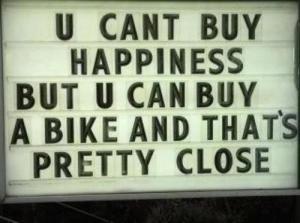If you are riding and training regularly, your pre ride checklist will soon become a part of your daily routine, second nature to brushing your teeth. But until the habit is formed, here is a pre ride check list that you should be executing, starting one and half hours, before every ride.
Stay Hydrated
Drink one glass of water as soon as you wake up. Continue to sip on water throughout the day. Drink another full glass of water before your ride. Drink one full water bottle for every hour while riding. If it is hot or you are wearing a heavy sweater you should also be consuming electrolytes or at the very least a dash of salt.
Stay Fuelled for the distance
Before a long ride eat a meal consisting of a mix of complex carbohydrates, fat and protein for sustained energy. Examples: eggs, avocado and toast or yogurt, banana and granola. Before a short intense ride eat a snack of simple carbohydrates that digests quickly. Examples: piece of fruit, energy bar, fruit shake. Pack and carry enough fuel with you for the duration of the ride. 200-300 calories per hour is the general rule.
Stay Focused
Before you get on your bike, you should know what your goal is. If you want to improve and get faster, every ride should have a purpose. The purpose could be to work on strength, endurance, power, technique, recovery or learning a new route. But once you have chosen a goal, stick to it.
Pump up
Pump your tires to 100-120 psi every time you ride. The pressure you choose will depend on the road conditions, the type of ride you are doing and your weight. The five minutes that it takes to pump up your tires can save you from a pinch flat on the road.
Be Prepared
Your bike should have a saddle bag containing all the supplies that you need to change a flat. Make sure that your saddle bag is fully stocked with the following items at all times.
- spares tube (or two if you are alone and on a long ride away from home)
- tire levers
- patch kit
- hand pump
- CO2 cartridge is optional
Be Prepared for the worst
Although we never plan on getting in an accident, it is always good to be prepared.
- Tell someone where you are going and when you plan on returning.
- Wear Road ID or carry ID with you along with an emergency contact number, particularly if you have allergies to medication or a specific medical condition.
- A cell phone and visa card can get you out of most emergencies.
Kristina Bangma
Head Coach and Owner of Kits Energy

 At 16 years old, I used my entire savings to buy my first road bike. It was a beautiful, hardly ridden, red Trek 1500. I grew up in Ontario so I rode that bike every day from Spring until Fall. I rode it to and from school and to my part time job as a lifeguard. On the weekends, I would explore old farm roads, challenging myself to ride further each week.
At 16 years old, I used my entire savings to buy my first road bike. It was a beautiful, hardly ridden, red Trek 1500. I grew up in Ontario so I rode that bike every day from Spring until Fall. I rode it to and from school and to my part time job as a lifeguard. On the weekends, I would explore old farm roads, challenging myself to ride further each week.